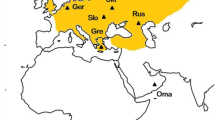Abstract
Western chipmunks (Neotamias) exhibit a complex geographical distribution and can vary by minute morphological differences. This has lead to confusion around the taxonomy and evolutionary history of this group. The main focus of this molecular study was to infer taxonomic relationships within Neotamias, especially at the tips of the tree. Sequences of the complete control region for 16 species of chipmunks (Tamias, Neotamias) were analyzed independently and in combination with previously published sequences of two mitochondrial genes, cytochrome b and cytochrome oxidase II. The control region data set corroborated the findings of Piaggio and Spicer (2001) in finding five discrete clades, while also providing stronger bootstrap support for most terminal branches. Analysis of individual mitochondrial genes revealed that not all genes have the same phylogenetic signal and when analyzed in combination, this incongruence amongst genes is resolved.



Similar content being viewed by others

Literature Cited
Allard MW, Carpenter JM (1996) On weighting and congruence. Cladistics 12:183–198
Applied Biosystems, Inc (1999) Sequencing Analysis, Version 3.4. Perkin Elmer Corp., Foster City, California
Demboski JR, Sullivan J (2003) Extensive mtDNA variation within the yellow-pine chipmunk, Tamias amoenus (Rodentia: Sciuridae), and phylogeographic inferences for northwest North America. Mol Phylogenet Evol 26:389–408
Felsenstein J (1978) Cases in which parsimony or compatibility methods will be positively misleading. Syst Zool 27:401–410
Felsenstein J (1985) Confidence limits on phylogenies: An approach using the bootstrap. Evolution 39:83–91
GeneCodes Corporation (1998) Sequencher, Version 3.1.1. Ann Arbor, Michigan
Hafner DJ (1984) Evolutionary relationships of the Nearctic Sciuridae. In: JO Murie, GR Michener (eds), Biology of ground dwelling squirrels, pp 3–23. University of Nebraska Press, Lincoln
Hall ML, Jones DS, Wood BA (1998) Evolution of the gibbon subgenera inferred from cytochrome b DNA sequence data. Mol Phylogenet Evol 10:281–286
Hassanin A, Douzery EJP (1999) The tribal radiation of the family Bovidae (Artiodactyla) and the evolution of the mitochondrial cytochrome b gene. Mol Phylogenet Evol 13:227–243
Hillis DM (1987) Molecular versus morphological approaches to systematics. Annu Rev Ecol Syst 18:23–42
Hillis DM (1995) Approaches for assessing phylogenetic accuracy. Syst Biol 44:3–16
Howell AH (1922) Diagnoses of seven new chipmunks of the genus Eutamias, with a list of the American species. J Mammal 3:178–185
Huelsenbeck JP, Hillis DM (1993) Success of phylogenetic methods in the four-taxon case. Syst Biol 42:247–264
Jameson Jr EW (1999) Host-ectoparasite relationships among North American chipmunks. Acta Theriol 44:225–231
Kocher TD, Wilson AC (1991) Sequence evolution of mitochondrial DNA in humans and chimpanzees: Control region and a protein-coding region. In: S Osawa, T Honjo (eds), Evolution of life, pp 391–413. Springer-Verlag, New York
Levenson H, Hoffman RS, Nadler CF, Deutsch L, Freeman SD (1985) Systematics of the Holoarctic chipmunk (Tamias). J Mammal 66:219–242
Mullis KB, Faloona F, Scharf S, Saiki R, Horn G, Erlich HA (1987) Specific enzymatic amplification of DNA in vitro: The polymerase chain reaction. Cold Spring Harbor Symp Quant Biol 51:263–273
Nadler CF, Hoffmann RS, Lay DM (1969) Chromosomes of the Asian chipmunk Eutamias sibiricus Laxmann (Rodentia: Sciuridae). Experientia 25:868–869
Nadler CF, Hoffman RS, Honacki JH, Pozin D (1977) Chromosomal evolution in chipmunks, with special emphasis on A and B karotypes of the subgenus Neotamias. Am Mid Nat 98:343–353
Patterson BD (1982) Pleistocene vicariance, montane islands, and the evolutionary divergence of some chipmunks (genus Eutamias). J Mammal 63:387–398
Piaggio AJ, Spicer GS (2000) Molecular phylogeny of the chipmunk genus Tamias based on the mitochondrial cytochrome oxdiase subunit II gene. J Mamm Evol 7:147–166
Piaggio AJ, Spicer GS (2001) Molecular phylogeny of the chipmunks inferred from mitochondrial cytochrome b and cytochrome oxidase II gene sequences. Mol Phylogenet Evol 20:335–350
Pollack DD, Zwickl DJ, McGuire JA, Hillis DM (2002) Increased taxon sampling is advantageous for phylogenetic inference. Syst Biol 51:664–671
Posada D, Crandall KA (1998) Modeltest: Testing the model of DNA substitution. Bioinformatics 14:817–818
Rohlf FJ (1982) Consensus indices for comparing classifications. Mathe Biosci 59:131–141
Saiki RK, Gelfand DH, Stoffel S, Scharf SJ, Higuchi R, Horn GT, Mullis KB, Erlich HA (1988) Primer-directed enzymatic amplification of DNA with thermostable DNA polymerase. Science 239:487–491
Shimodaira H, Hasegawa M (1999) Multiple comparisons of log-likelihoods with applications to phylogenetic inference. Mol Biol Evol 16:1114–1116
Swofford DL (2001) PAUP*. Phylogenetic Analysis Using Parsimony (* and Other Methods), Version 4.0b8. Sinauer, Sunderland, Massachusetts
Werman SD, Springer MS, Britten RJ (1990) Nucleic acids I: DNA and DNA hybridization. In: DM Hillis, C Moritz, BK Mable (eds), Molecular systematics (2nd edn), pp 169–203, Sinauer, Sunderland, Massachusetts
White A (1953) Genera and subgenera of chipmunks. Univ Kansas Publ Mus Nat Hist 5:545–561
Zwickl DJ, Hillis DM (2002) Increased taxon sampling greatly reduces phylogenetic error. Syst Biol 51:588–598
Acknowledgments
We thank the Museum of Southwestern Biology for many of the tissue samples. We also thank the University of California Museum of Vertebrate Zoology, the Burke Museum of Natural History, and the Carnegie Museum of Natural History. We would like to thank Eric Routman and Robert Patterson for their useful comments and suggestions during the editing process. We would also like to thank Corrie Saux, Maria DeAngelo, and Rebecca Carson for their support and advice. Thanks to Frank Cipriano and Craig Reading of the SFSU Conservation Genetics Lab for their instruction in molecular techniques. This work was partly funded by a Research Infrastructure in Minority Institutions award from the National Center for Research Resources with funding from the Office of Research on Minority Health, NIH 5 P20 RR11805 awarded to G.S.S.
Author information
Authors and Affiliations
Corresponding author
Rights and permissions
About this article
Cite this article
Banbury, J.L., Spicer, G.S. Molecular Systematics of Chipmunks (Neotamias) Inferred by Mitochondrial Control Region Sequences. J Mammal Evol 14, 149–162 (2007). https://doi.org/10.1007/s10914-006-9035-1
Published:
Issue Date:
DOI: https://doi.org/10.1007/s10914-006-9035-1



